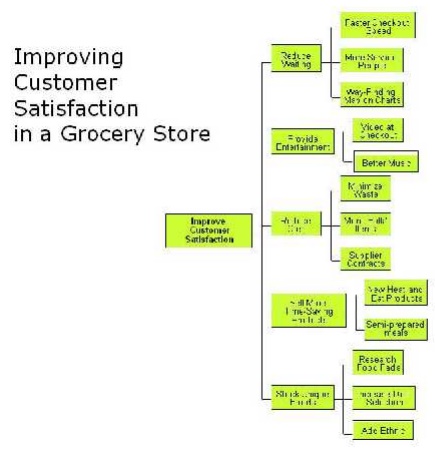Chapter: Mechanical : Total Quality Management (TQM) : TQM Tools & Techniques
Management Tool: Tree Diagram
New Seven management Tools
It is a simple and effective tool. This approach focuses on the process (to reveal the causes), rather than the people.
Example: Why was there a delay in dispatch of good? Cutting tool failed, resulting in delay in manufacture. Why? The tools were reused?
Why? Ordered tool were not delivered?
Solution changes the dispatch schedule, if ever the tools were not delivered.
Forced Field Analysis
ReadersŌĆÖ attention is invited to the discussion in Chapter 2 on this topic.
Nominal Group Technique
This technique provides for ideas input from every one in the team and for effective decision making.
A team wants to decide upon a current complaint to attend. Every one in the team writes the problem on a paper, what they think is most important. They are listed in a chart and then the team members are asked to rank, from most important to least important. The ranking are given a numerical value starting from, say, on a 10 to 1 scale. Points for each problem is totaled and the ones with highest number of points, is considered o be the most important.
The seven advanced tools of quality management or the ŌĆśNew SevenŌĆÖ is a collection of tools put together by a set of Japanese quality professionals. , Arrow Diagram, was known to engineers and project managers by names like PERT (Programme Evaluation and Review Technique) or CMP (Critical Mean Path). Another tool in this set PDPC (Process Decision Programme Chart) has been used in operations research.
CONCEPT
These tools, unlike SPC tools are qualitative tools. Most of these tools do not involve the use of numerical data.
. Like all management tools these are judgmental tools.
Managers are often called upon to make decisions based on their judgement with help of incomplete information or on subjective issues.
Team work and techniques like brainstorming are very essential for best results with such tools.
The seven tools we will see are :
1. Affinity diagram
2. Relations diagram
3. Tree diagram
4. Matrix diagram
5. Matrix data analysis diagram .
6 .Process decision programme chart
7. Arrow diagram
Tree Diagram
Purpose
The purpose of the tree diagram is to explore ways and means to achieve an objective, develop a list of alternate means to reach the desired situation in a sequential order and to present them in a visual form.
Procedure
This tool like other tools in the ŌĆśnew sevenŌĆÖ is a group tool. A brainstorming session is necessary to collect a large number of ideas for the means to achieve the objective. The rules of brainstorming should be observed to get the best results from the tool.
The steps in the procedure to develop a tree diagram are :
Identify a high priority problem that needs to be solved at the earliest. Prepare an objective statement describing the desired situation or the target solution.
2. Decide the appropriate form of the diagram - cascade or tree as well as direction of flow after a brief discussion. Place the target solution in the dark rectangle.
3. Brainstorm to identify the primary means to achieve the objective. Arrange them in an appropriate order keeping in mind the likely interrelations between them and place them in rectangles at the first level.
4. For each of the primary means, identify secondary means which would be necessary to attain those means. Arrange them in next level boxes.
5. Identify tertiary means required to attain each of the secondary means and place them in a proper order in the next level boxes.
6. Continue the process till the group feels that the end of the line has been reached.
7. If a lower level means is required to attain two higher level means, it may be connected to both. Rearrange the boxes if necessary to make this possible. Use of POST-IT pads can make such a rearrangement simple.
8. Brainstorm to reach a consensus on the relative importance of the last level means to priorities action.
9. Give a suitable title to the diagram. Application The most important application of the tree diagram is for devising solutions for problems. It helps one to develop a systematic step by step strategy to achieve an objective. It is also useful in monitoring the implementation of solutions by taking care of accomplishment of means at different levels.

Related Topics